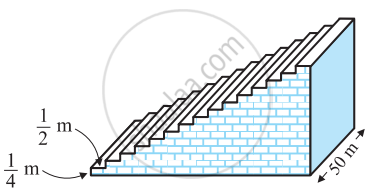Advertisements
Advertisements
Question
The first and last terms of an AP are a and l respectively. Show that the sum of the nth term from the beginning and the nth term form the end is ( a + l ).
Solution
In the given AP, first term = a and last term = l.
Let the common difference be d.
Then, nth term from the beginning is given by
Tn = { l- (n-1) d} ................(1)
Similarly, nth term from the end is given by
Tn ={ l -(n-1) d} ................(2)
Adding (1) and (2), we get
a+(n-1) d + { l-(n-1) d}
= a+ (n-1) d+l (n-1) d
= a+1
Hence, the sum of the nth term from the beginning and the nth term from the end (a +1).
APPEARS IN
RELATED QUESTIONS
A sum of Rs 700 is to be used to give seven cash prizes to students of a school for their overall academic performance. If each prize is Rs 20 less than its preceding prize, find the value of each of the prizes.
A small terrace at a football field comprises 15 steps, each of which is 50 m long and built of solid concrete. Each step has a rise of `1/4` m and a tread of `1/2` m (See figure). Calculate the total volume of concrete required to build the terrace.
[Hint: Volume of concrete required to build the first step = `1/4 xx 1/2 xx 50 m^3`]

Find the sum 25 + 28 + 31 + ….. + 100
Which term of the AP 21, 18, 15, …… is -81?
Find the sum of the following Aps:
9, 7, 5, 3 … to 14 terms
The term A.P is 8, 10, 12, 14,...., 126 . find A.P.
How many terms of the series 18 + 15 + 12 + ........ when added together will give 45?
If the second term and the fourth term of an A.P. are 12 and 20 respectively, then find the sum of first 25 terms:
The sum of all odd integers between 2 and 100 divisible by 3 is ______.
Find the sum of those integers from 1 to 500 which are multiples of 2 or 5.
[Hint (iii) : These numbers will be : multiples of 2 + multiples of 5 – multiples of 2 as well as of 5]
